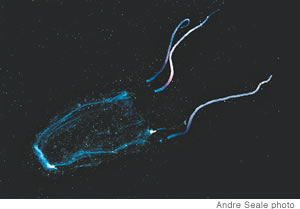Where Do Box Jellyfish Come From?

Angel Yanagihara studies box jellyfish
They arrive seven to 10 days after a full moon, quietly swimming ashore while most of us are still asleep. Their journey to the shallow waters off Waikiki Beach is a personal one: They are here to spawn.
But the Hawaiian box jellyfish is also a painful monthly visitor.
Since 1997, University of Hawaii assistant professor Angel Yanagihara has studied the box jellyfish in order to gain a better understanding of the mysterious creatures and ultimately find a soothing solution to its needle-like stings.
Yanagihara and her assistants often arrive before 2:30 a.m. near the Kapahulu groin during the monthly influx to gather the animals that have found their way to shore. Armed with a wetsuit, a body board, dive gloves and a bucket, she searches for the jellies, which are attracted to her dive light. They appear in the water like little transparent plastic sacks with pink threads. But there is nothing delicate about their sting.
Yanagihara understands the potency of its venom. The veteran biochemist experienced a severe respiratory reaction when she swam into a cluster of jellies several years ago. Thousands of stinging capsules wrapped around her neck, arms and legs. She says about 1 percent of the population experiences a severe type of respiratory failure or distress from its venom. She is part of that 1 percent, and she knows she got lucky.
In 2001, Yanagihara and her assistants gathered 10,261 animals; in 2008, nearly 8,500 including nearly 2,500 in the month of November alone. It’s these large influxes that motivate Yanagihara to learn more about the venom in order to develop a treatment when thousands of microscopic spiny splinters poke through the skin of unsuspecting victims.
So during Halloween weekend, she went beyond the shoreline to see where the creatures come from.
“I’ve been asking the question for 12 years, wondering where they live and where they come,” says Yanagihara.
She and several other biochemists did a night dive off Waikiki in search of answers. They entered the water shortly before midnight and stayed in the ocean for nearly four hours.

Box jellyfish look delicate but have a needle-like sting
“We’ve been working with physical oceanographers at UH and went off shore at the predicted sites and we were fabulously successful,” says an excited Yanagihara, who could not reveal where the animals were spotted except to say, “We found our little critters swimming on a beeline to shore.”
Yanagihara says what made the discovery even more exciting was the jellies were captured in action by a crew from the Discovery Channel who filmed in 3-D.
“We got footage from boat, topside, and then we dove in and filmed the animals as they were swimming toward shore. It was fabulous,” says Yanagihara. “This is Discovery’s brand new 3-D home television channel, which will debut in January. We’re in the very first documentary on this brand new station!”
Yanagihara says they continued their dive at 4 a.m., “and followed these guys all the way to shore.” She says the box jellyfish are strong swimmers, reaching speeds of up to 1 to 2 knots.
During last week’s influx, more than 1,700 box jellyfish invaded the southern shores of Oahu on the first day, stinging more than 135 visitors at Waikiki Beach alone. Scientists believe it is an indication that the population is as strong as ever.
More night dives are scheduled for the near future and soon the question, “Where do they come from?” will finally be answered.



